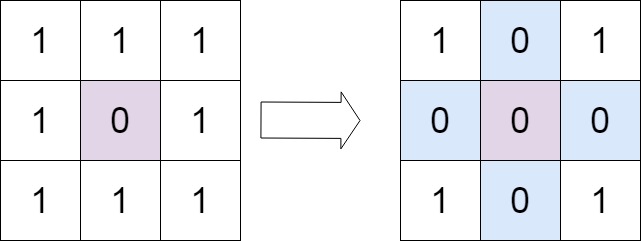Given an m x n integer matrix matrix, if an element is 0, set its entire row and column to 0's.
You must do it in place.
Example 1:

Input: matrix = [[1,1,1],[1,0,1],[1,1,1]]
Output: [[1,0,1],[0,0,0],[1,0,1]]
Example 2:

Input: matrix = [[0,1,2,0],[3,4,5,2],[1,3,1,5]]
Output: [[0,0,0,0],[0,4,5,0],[0,3,1,0]]
Constraints:
m == matrix.length
n == matrix[0].length
1 <= m, n <= 200
231 <= matrix[i][j] <= 231 - 1
Follow up:
O(mn) space is probably a bad idea.O(m + n) space, but still not the best solution.給定一個整數 matrix
對每個 matrix[i][j] = 0 對應的 i row 與 j column 的值全部更改為 0
要求寫一個演算法去做以上的操作

為了避免修改後的值 去影響判斷式
所以最直觀的作法是先複製原 matrix 來作為參照值
如下圖

然後逐步依據所在 row, col 中是否有需要改成零做更改
然而可以發現 其實每次只要有一個 matrix[row][col] 影響的就是整個 row 與 col
所以其實只需要紀錄 哪個 row 以及哪一個 col 需要做修改
可以簡化如下

這樣來做就可以讓空間複雜度從 O(m*n) 降低至 O(m+n)
而時間複雜度是 O(m*n)
然而 可以發現只要從上而下 由左至右來做比較
可以利用第0 列第0行來做標記
標記完再根據標記過的行列來做修改
需要注意的是 因為 matrix[0][0] 因為會同時在第 0 列與第0行交會點
所以需要額外多一個儲存空間來標記
以下多使用一個 firstColumnZero 用來標記第 0 column 是否需要改成 0
matrix[0][0] 代表第 0 row 是否要改成 0
如下

透過這個方法 先標記
然後在根據標記去修改對應的值
就可以把 空間複雜度降低到 O(1)
而時間複雜度因為需要跑完整個 matrix 所以還是 O(m*n)
package sol
func setZeroes(matrix [][]int) {
firstColumnZero := false
ROW, COL := len(matrix), len(matrix[0])
// mark matrix[0][col] = 0 , matrix[row][0] = 0 if matrix[row][col] = 0
for row := 0; row < ROW; row++ {
for col := 0; col < COL; col++ {
if matrix[row][col] == 0 {
// mark row
matrix[row][0] = 0
// mark col
if col == 0 {
firstColumnZero = true
} else {
matrix[0][col] = 0
}
}
}
}
// 1..ROW-1, 1..COL-1 , if matrix[row][0] = 0 || matrix[0][col] = 0, matrix[row][col] = 0
for row := 1; row < ROW; row++ {
for col := 1; col < COL; col++ {
if matrix[row][0] == 0 || matrix[0][col] == 0 {
if matrix[row][col] != 0 {
matrix[row][col] = 0
}
}
}
}
// check first row
if matrix[0][0] == 0 {
for col := 0; col < COL; col++ {
if matrix[0][col] != 0 {
matrix[0][col] = 0
}
}
}
if firstColumnZero {
for row := 0; row < ROW; row++ {
if matrix[row][0] != 0 {
matrix[row][0] = 0
}
}
}
}
